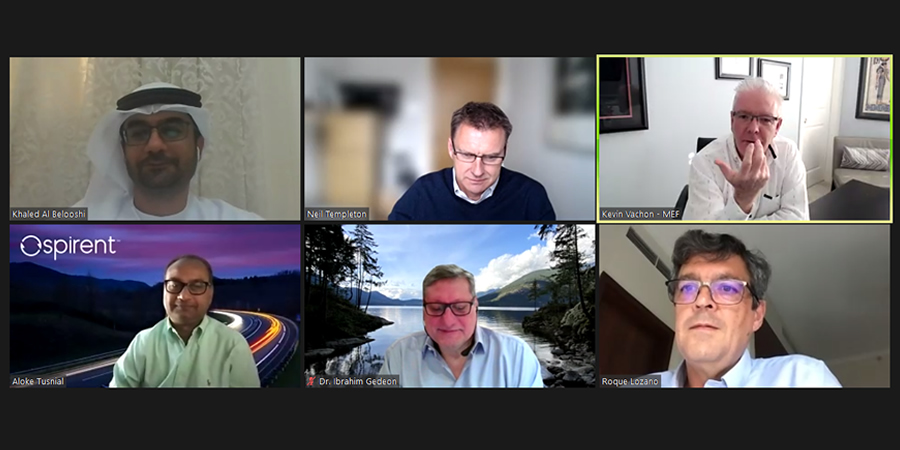Telecom Review organized a virtual panel on April 27, 2021, where industry experts discussed the topic of network automation & SD-WAN in the era of virtualization. The esteemed panelists included:
- Mr. Roque Lozano, SVP IP & Optical Networks, MEA, Nokia
- Mr. Aloke Tusnial, Vice President, Cloud Business & Solutions, Spirent
- Mr. Khaled Al Belooshi, VP Fixed Networks, Etisalat
- Mr. Neil Templeton, Vice President, Digital Innovation Marketing, PCCW Global
- Dr. Ibrahim Gedeon, CTO, TELUS
The panel discussion was moderated by Mr. Kevin Vachon, Chief Operating Officer, MEF.
Moving forward with the topic of network automation, the panel thought that the process of initiating automation was easier said than done. It felt that most providers hit a wall when it came to the implementation of automation when allocating the right IT resources and capabilities and is somewhat of a slow and gradual process. “Is that a day-to-day challenge for all?” was the question that the panelists explored.
Taking the question head-on, Dr. Ibrahim Gedeon felt that when it came to automation, the keyword was doing it by design from scratch. “But a company like ours doesn’t have the luxury for certain things as we try to move the mothership; however, we are leveraging the new technologies with the new mode of operations. Automation wave goes along with technology waves and it is key for us as we see more and more investment in processes, we will dovetail it into the new instead of moving everything altogether which will be daunting no matter how big or small you are,” he explained.
Joining the conversation, Khaled Al Belooshi said that in Etisalat, the virtualization journey has started 2 to 3 years ago. “We build the telco cloud and there are so many services that are virtualized. In addition to that we started the automation, we have an end-to-end service orchestrator. With automation, the orchestrator can deliver the experience that we are looking for to our customers. We have done a lot in that area and we are providing to our customers already,” he said.
Turning the discussion toward the scope of end-to-end orchestration, the panel explored the strategies to address the issue of the complexity of automation.
To illustrate the point of discussion, Neil Templeton cited the example of PCCW integrating operations with Console Connect three years ago. “We had to restructure the whole business to fit the new model for the coming together of network infrastructure and network engineers (PCCW) with software and software developers (Console Connect), trying to get the two organizations and bringing them together,” he said. “We adopted a scaled agile framework right across the business, everyone went through training to develop services together. We started by automating our network and went through integration to all of the clouds and integrated at the network layer and application layer to all the major hyper-scale players to provide services. We integrated with SASE application providers to provide direct provisions to workloads and bringing more services to that fabric,” he explained.
Roque Lozano felt that the challenge of implementing automation was that networks are always working with the increase in traffic volumes with different patterns and time shifts; enterprise networks becoming residential networks because of remote working or schooling from home. Unfortunately, all of this evolution of the traffic has been facing price competition. The carriers and suppliers are trying to deliver more with less for sustainability, so we as a sector have to sell our value better. And automation could help us to do that,” he opined.
In conclusion, Aloke Tusnial said that automation is a must and concurred that the Covid19 pandemic had accelerated the way for automation. He said that automation has to be intentional. “Most telecommunication providers are automating either at the planning and engineering space or even at the operational space. But as you are automating you can’t only look at the sunny day scenario but also need a plan, when things go wrong, how do you manage that?” he inferred.
“As you put more and more logic into your automation, you have fewer and fewer people who know how things work. For automating the troubleshooting and self-healing process, enough data must be fed to stress test the processes, making sure that it will work no matter what the situation to provide everything on-demand and control the highs and lows of the stress from demands,” he explained.
